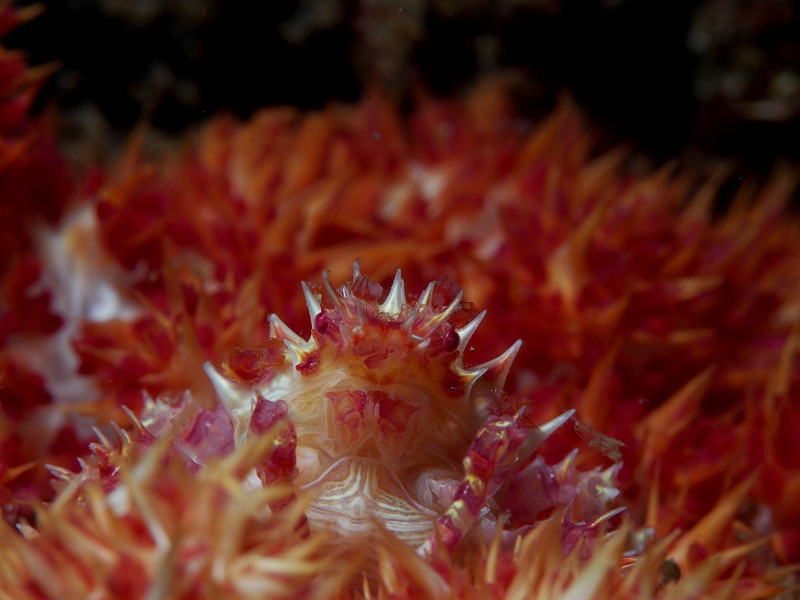Candy Crab Facts
- This dazzlingly colored Crustacean most frequently goes by the common name of the Candy Crab for wholly understandable reasons. This marvel of Nature also goes by several other general names, however. None are as appealing to the senses, however.
- These alternate terms include such distinctive appellations as the commensal soft coral crab, the Oates’s soft coral crab, and the Dendronephthya crab. Most of them, though, suitably serve to describe the unique Arthropod in at least one way or another.
- Meanwhile, scientific professionals, such as researchers, typically refer to the creature by its scientific name. That’s the somewhat hard to pronounce term of Hoplophrys oatesi. This tiny wonder further represents the sole member of its entire genus.
- The highly respected American malacologist and educator John Henderson Jr, made the first formal acknowledgement of the animal as a separate and distinct species. The eminent researcher made this scientifically noteworthy recognition in the year 1893.
- The Candy Crab appears to be maintaining a population base that’s both sizeable and stable. This status also seems to hold true throughout the entirety of its natural range. The IUCN, therefore, currently has no listing for it the organization’s Red List.
- The delicate wonder of evolution nevertheless must be considered to be facing at least some threats to its existence, though. Habitat loss certainly poses a possible danger. It’s greatest threat, however, likely consists of the ongoing threat of climate change.
Related Articles
Candy Crab Physical Description
The stunning invertebrate known as the Candy Crab easily draws the eye of those fortunate enough to encounter it. The impressive creature’s best known for its appearance, though, not it’s size. That’s because it evolved as an extremely tiny species of crustacean.
Unlike many of its brethren, however, this remarkable animal displays no noticeable degree of the physiological characteristic of sexual dimorphism. Distinguishing the genders therefore often presents a challenge for any but the trained professional.
This tendency further extends to both appearance and size. Mature adults of both genders attain an overall body length measuring roughly 0.6 – 0.8 in (1.5 – 2 cm). Exceptional specimens do occur, of course, but even these rarely exceed this size by much.
The body of adult individuals, of both sexes, also manifests numerous sharply pointed spines extending outward. Out of its five pairs of legs, the first pair possesses small claws. While small, these two appendages nonetheless remain comparatively powerful.
Yet its the coloring of the gorgeous Candy Crab that generally garners the most appreciation. That’s due to the fact that this consists of numerous colors, typically bright. These vary between individuals, to fit its location, but include yellow, pink, orange, and white.
- Kingdom: Animalia
- Phylum: Arthropoda
- Class: Malacostraca
- Order: Decapoda
- Family: Epialtidae
- Genus: Hoplophrys
- Species: H. oatesi
Candy Crab Distribution, Habitat, and Ecology
Fortunately, both for the Decapod itself, and those who appreciate Nature, the Candy Crab inhabits a comparatively broad swathe of the globe. That’s due to the fact that the amazing animal evolved as endemic to the majority of the beautiful Indo-Pacific region.
This includes large portions of the coastlines of both North America and South America, for starters. Yet the intrepid species also appears along the shores of Europe and Africa, as well. But its greatest concentration lies along the shores of Australia and Asia.
Even there, though, it displays decided preferences in its choice of habitat that limit its potential range. That’s because it only inhabits the relatively shallow regions. This most frequently occurs along the coastlines, of course, but also extends to near islands.
More specifically, it only makes its home within a very small range of depths. This extends from a known maximum of 295 ft (90 m) to roughly 3.3 ft (1 m). It also typically resides either on or very near sections of coral. There, its coloring provides excellent camouflage.
The magnificent Candy Crab also developed a mutually beneficial relationship with its host coral. It keeps the coral clean of debris, and even defends it from predators. For disguise, the animal even cuts off polyps from the coral, and attaches them to its own shell!
The host coral, meanwhile, provides the diminutive crab with both shelter and food from its own leftovers. This wonder of evolution most frequently consumes quantitites of plankton, however. Its own predators consist of a wide range of species, including various fish.
Species Sharing Its Range
Check out our other articles on 4 Stunning North American Snakes, Long-Horned Orb Weaver, Gulf Hagas, Nepenthes pervillei, California red-sided garter snake, Shoebill, Japanese Hare

